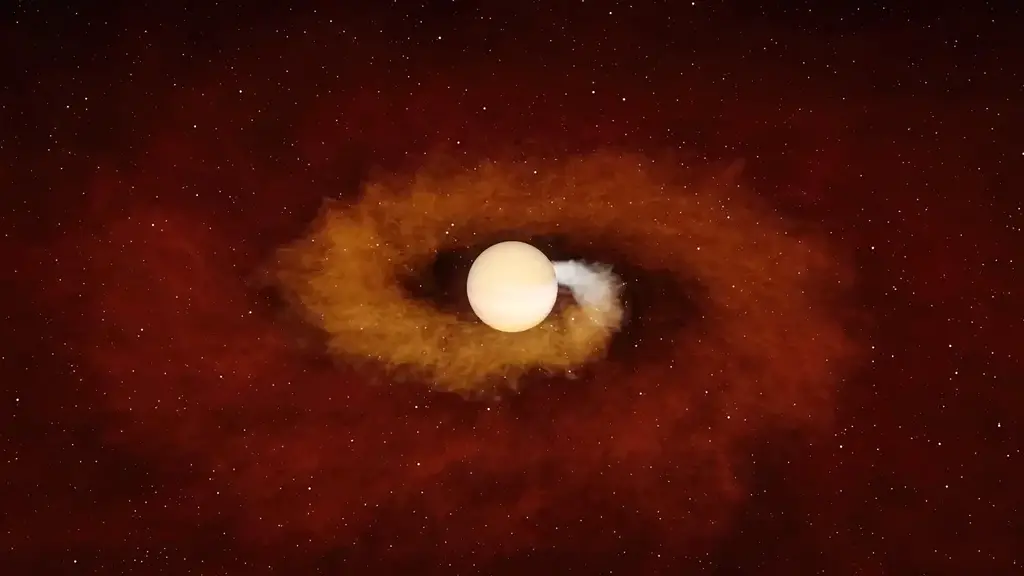Intrappolati nell'atto: Gli astronomi rilevano per la prima volta una stella che divora un pianeta.

Questa illustrazione mostra il progressivo avvicinamento di un pianeta alla sua stella-ospite, finché non spiraleggia verso di essa. Il pianeta grande quanto Giove strappa il gas alla stella, facendolo finire nello spazio. Lì, il gas si raffredda e diventa polvere, che diventa visibile agli astronomi. Crediti: R. Hurt & K. Miller (Caltech/IPAC)
Una stella che sta per giungere alla fine della sua vita si è ingrossata e ha assorbito un pianeta grande quanto Giove. Tra circa 5 miliardi di anni, il nostro sole seguirà un processo simile alla fine della sua vita.
In una scoperta innovativa, gli astronomi hanno osservato per la prima volta una stella vecchia che consumava un pianeta, fornendo informazioni sulla futura sorte del nostro Sole, che subirà un processo simile tra circa 5 miliardi di anni.
Un nuovo studio pubblicato sulla rivista Nature documenta la prima osservazione di una stella vecchia che inghiotte un pianeta. Dopo essersi esaurita la carica nel suo nucleo, la stella iniziò a crescere di dimensioni, riducendo la distanza con il pianeta vicino e consumandolo completamente. Tra circa 5 miliardi di anni, il nostro Sole seguirà un processo simile di invecchiamento, arrivando probabilmente a 100 volte il diametro attuale e diventando ciò che è noto come una gigante rossa. Durante questa fase di crescita, assorbirà Mercurio, Venere e forse la Terra.
Gli astronomi hanno identificato molte stelle giganti rosse e sospettato che in alcuni casi consumino pianeti vicini, ma il fenomeno non era mai stato osservato direttamente prima. "Questo tipo di evento è stato previsto da decenni, ma finora non abbiamo mai osservato come si svolge questo processo", ha detto Kishalay De, un astronomo presso il Massachusetts Institute of Technology di Cambridge e autore principale dello studio.
In questo video è illustrato il lento declino di un pianeta in orbita intorno a una stella in crescita. Il pianeta strappa uno spruzzo di gas dalla stella mentre si avvicina a spirale. Una volta che il pianeta viene divorato, la stella aumenta di luminosità e dimensioni, ma tornerà eventualmente a essere come prima della fusione.
I ricercatori hanno scoperto l'evento - formalmente chiamato ZTF SLRN-2020 - utilizzando più osservatori a terra e il satellite NEOWISE (Near-Earth Object Wide Field Infrared Survey Explorer) della NASA, gestito dal Jet Propulsion Laboratory dell'agenzia. Il pianeta era probabilmente grande quanto Giove, con un'orbita ancora più vicina alla sua stella rispetto a quella di Mercurio al nostro Sole. La stella si trova all'inizio della fase finale della sua vita - la fase della gigante rossa, che può durare più di 100.000 anni.
Man mano che la stella si espandeva, la sua atmosfera esterna circondava infine il pianeta. La resistenza dell'atmosfera ha rallentato il pianeta, riducendo la sua orbita e inviandolo infine sotto la superficie visibile della stella, come una meteora che brucia nell'atmosfera terrestre. Il trasferimento di energia ha fatto temporaneamente aumentare le dimensioni della stella e diventare alcune centinaia di volte più luminosa. Osservazioni recenti mostrano che la stella è tornata alle dimensioni e alla luminosità che aveva prima di fondersi con il pianeta.
Questa illustrazione mostra il Wide-field Infrared Survey Explorer, o WISE, il satellite, in orbita attorno alla Terra. Nella sua missione NEOWISE, scopre e caratterizza asteroidi.
L'esplosione di luce ottica (visibile all'occhio umano) dopo la fine del pianeta è stata osservata dalle osservazioni del Zwicky Transient Facility (ZTF) guidato dal Caltech, uno strumento basato all'Osservatorio di Palomar nel sud della California che cerca eventi cosmici che cambiano rapidamente di luminosità, a volte in poche ore. De stava utilizzando ZTF per cercare eventi chiamati novae - quando una stella morta e collassata (conosciuta come una nana bianca) si nutre di gas caldo da un'altra stella vicina. Le novae sono sempre circondate da flussi di gas caldo, ma le osservazioni sul fulmine di altri telescopi a terra hanno mostrato gas e polveri molto più freddi che circondavano la stella, il che significa che non assomigliava a una nova o a qualsiasi altra cosa che De avesse mai visto.
Allora si rivolse all'osservatorio NEOWISE, che scandaglia il cielo intero con la luce infrarossa (una gamma di lunghezze d'onda più lunghe della luce visibile) ogni sei mesi. Lanciato nel 2009 e originariamente chiamato WISE, l'osservatorio produce mappe dell'intero cielo che consentono agli astronomi di vedere come gli oggetti cambiano nel tempo.
Questa è un mosaico di immagini che coprono l'intero cielo osservato dal Wide-field Infrared Survey Explorer (WISE), parte del suo rilascio dei dati All-Sky.
Looking at the NEOWISE data, De saw that the star brightened almost a year before ZTF spotted the flash. That brightening was evidence of dust (which emits infrared light) forming around the star. De and his colleagues think the dust indicates that the planet didn’t go down without a fight and that it pulled hot gas away from the puffy star’s surface as it spiraled toward its doom. As the gas drifted out into space, it would have cooled and become dust – like water vapor becoming snow. Even more gas was then flung into space during the collision of the star and the planet, producing more dust visible to both the ground-based infrared observatories and NEOWISE.
“Very few things in the universe brighten in infrared light and then brighten in optical light at different times,” said De. “So the fact that NEOWISE saw the star brighten a year before the optical eruption was critical to figuring out what this event was.”
Five billion years from now, when our Sun is expected to become a red giant, swallowing up Mercury, Venus, and possibly Earth, the light show should be much more subdued, according to De, since those planets are many times smaller than the Jupiter-size planet in the ZTF-captured event.
“If I were an observer looking at the solar system 5 billion years from now, I might see the Sun brighten a little, but nothing as dramatic as this, even though it will be the exact same physics at work,” he said.
Most mid-size stars will eventually become red giants, and theorists think that a handful of them consume nearby planets each year in our galaxy. The new observations provide astronomers with a template for what those events should look like, opening up the possibility of finding more.
“This discovery shows that it’s worthwhile to take observations of the entire sky and archive them, because we don’t yet know all of the interesting events we might be capturing,” said Joe Masiero, deputy principal investigator for NEOWISE at IPAC at Caltech. “With the NEOWISE archive, we can look back in time. We can find hidden treasures or learn something about an object that no other observatory can tell us.”
For more on this discovery:
Launched in 2009, the WISE mission surveyed the entire sky in infrared light twice, capturing images of around three-quarters of a billion celestial objects, such as distant galaxies, stars, and asteroids. The mission concluded in 2011, but in 2013, NASA repurposed the spacecraft for tracking asteroids and other near-Earth objects (NEOs), rebranding both the mission and the spacecraft as NEOWISE.
NASA’s Astrophysics Division within the Science Mission Directorate had JPL manage and operate WISE, with Edward Wright from UCLA serving as the principal investigator. The mission was competitively chosen under NASA’s Explorers Program, managed by the agency’s Goddard Space Flight Center in Greenbelt, Maryland.
JPL manages and operates the NEOWISE mission on behalf of NASA’s Planetary Defense Coordination Office within the Science Mission Directorate in Washington. The University of Arizona hosts the principal investigator, Amy Mainzer. The Space Dynamics Laboratory in Logan, Utah, constructed the scientific instrument, while Ball Aerospace & Technologies Corp. of Boulder, Colorado, built the spacecraft. IPAC at Caltech in Pasadena handles science data processing, and Caltech manages JPL for NASA.




